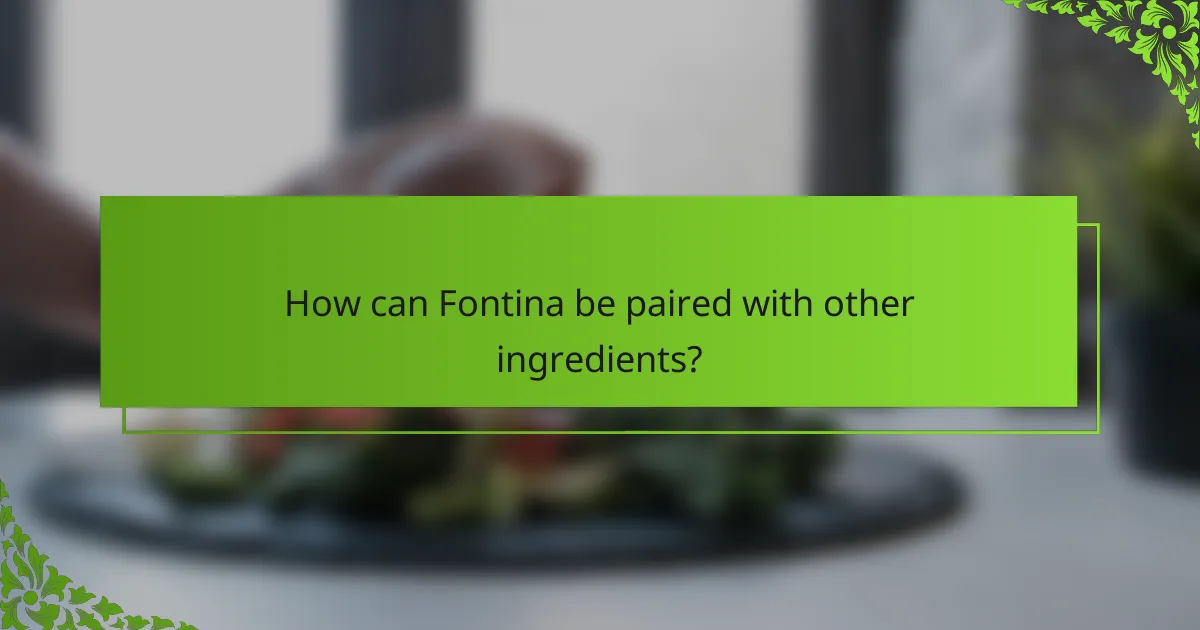Fontina cheese, a semi-soft Italian cheese from the Aosta Valley, is celebrated for its creamy texture and nutty flavor. This cheese, made from cow’s milk, features a pale yellow color and small holes formed during its aging process of at least three months. The article explores the culinary applications of Fontina, particularly in grilled cheese sandwiches and creamy sauces, highlighting its excellent melting properties. It also discusses ideal pairings with fruits, nuts, vegetables, and meats, which enhance Fontina’s flavor profile and versatility in gourmet dishes. Additionally, readers will learn how to effectively incorporate Fontina into various recipes, elevating their dining experience.

What is Fontina cheese and what makes it unique?
Fontina cheese is a semi-soft cheese originating from Italy, specifically the Aosta Valley. It is known for its creamy texture and rich, nutty flavor. Fontina is made from cow’s milk and has a distinctive pale yellow color. Its unique attribute is the presence of small holes, which are formed during the aging process. The cheese is aged for at least three months, allowing its flavor to develop further. Fontina is often used in fondue and creamy sauces due to its excellent melting properties. It pairs well with fruits, nuts, and robust wines, enhancing its culinary versatility.
How does the texture of Fontina influence its culinary applications?
The texture of Fontina significantly influences its culinary applications. Fontina has a semi-soft texture, which allows it to melt smoothly. This melting quality makes it ideal for creamy dishes like fondue and sauces. The texture also enhances its use in grilled cheese sandwiches, providing a rich, gooey experience. Additionally, its texture allows for easy shredding and slicing, making it versatile in various recipes. The semi-soft nature contributes to its ability to blend well with other ingredients, enhancing flavor profiles. Fontina’s texture is a key factor in its popularity in Italian cuisine, particularly in pasta dishes and risottos.
What are the specific characteristics of Fontina’s texture?
Fontina has a creamy and smooth texture. This cheese is semi-soft, allowing it to melt easily. The texture is often described as supple and elastic. Fontina’s consistency contributes to its rich mouthfeel. It has a slightly grainy surface, which is characteristic of aged varieties. The cheese also exhibits a buttery quality when melted. These attributes make Fontina ideal for creamy dishes and fondues. Its texture enhances the overall sensory experience in culinary applications.
How does Fontina’s texture compare to other cheeses?
Fontina has a creamy and smooth texture that sets it apart from many other cheeses. Its consistency is semi-soft, making it melt beautifully when heated. This melting quality is superior to firmer cheeses like cheddar, which can become oily. In comparison to softer cheeses like brie, Fontina remains more elastic and less runny. The texture of Fontina also offers a rich mouthfeel, enhancing dishes like grilled cheese. Overall, Fontina’s unique texture contributes to its versatility in cooking and pairing with various ingredients.
What are the best uses of Fontina in grilled cheese sandwiches?
Fontina is best used in grilled cheese sandwiches for its creamy texture and rich flavor. It melts beautifully, creating a gooey consistency that enhances the sandwich experience. Combining Fontina with sharper cheeses like cheddar adds depth to the flavor profile. Pairing it with fresh herbs or roasted vegetables elevates the taste further. Using Fontina in combination with crusty bread provides a satisfying crunch. This cheese also works well with various meats, such as prosciutto or turkey, for added protein. Its versatility allows for creative variations, making it a favorite among gourmet grilled cheese enthusiasts.
How does Fontina enhance the flavor profile of grilled cheese?
Fontina enhances the flavor profile of grilled cheese by adding a creamy, nutty taste. This cheese melts beautifully, creating a rich texture that elevates the sandwich. Its slight sweetness complements the savory elements of bread and other fillings. Fontina’s complex flavor profile includes hints of earthiness and a mild tang. This complexity contrasts well with traditional cheeses like cheddar. The melting characteristics of Fontina contribute to a gooey, satisfying bite. Studies show that Fontina’s fat content contributes to its superior melting quality. This makes it a preferred choice for gourmet grilled cheese variations.
What are some popular variations of grilled cheese using Fontina?
Popular variations of grilled cheese using Fontina include the Fontina and mushroom grilled cheese, and the Fontina and caramelized onion grilled cheese. The Fontina and mushroom variation features sautéed mushrooms that enhance the cheese’s creamy texture. This combination creates a rich and savory flavor profile. The Fontina and caramelized onion variation adds sweetness from the onions, balancing the cheese’s richness. Both variations utilize Fontina’s melting properties, resulting in a gooey and satisfying sandwich. These combinations showcase Fontina’s versatility in creating gourmet grilled cheese options.

How can Fontina be paired with other ingredients?
Fontina can be paired with a variety of ingredients to enhance its flavor. It complements earthy vegetables like mushrooms and spinach. Fontina also works well with meats such as prosciutto and chicken. Fruits like pears and figs provide a sweet contrast. Nuts, particularly walnuts and hazelnuts, add texture and depth. Additionally, herbs like thyme and rosemary elevate its aromatic qualities. These pairings highlight Fontina’s creamy texture and nutty taste. Chefs often use these combinations in gourmet dishes to achieve balance.
What are the ideal food pairings for Fontina cheese?
The ideal food pairings for Fontina cheese include mushrooms, truffles, and nuts. These ingredients enhance the cheese’s creamy texture. Fontina also pairs well with cured meats like prosciutto and salami. Fruits such as pears and figs complement its flavor profile. Bread, especially crusty types, works well for serving. Additionally, it goes nicely with hearty vegetables like roasted peppers and zucchini. Wine pairings include Chardonnay and Pinot Noir, which balance Fontina’s richness. These combinations highlight the cheese’s unique characteristics and elevate the dining experience.
Which meats complement Fontina in dishes?
Pork, beef, and chicken complement Fontina in dishes. Pork, especially prosciutto, adds a salty richness that enhances Fontina’s creamy texture. Beef, such as steak or ground beef, provides a hearty contrast to the cheese. Chicken, particularly grilled or roasted, offers a mild flavor that pairs well with Fontina’s nuttiness. These meats are commonly used in recipes that highlight Fontina’s flavor profile. Their varying textures and tastes create a balanced dish when combined with Fontina.
How do vegetables and herbs enhance the experience of Fontina?
Vegetables and herbs enhance the experience of Fontina by complementing its creamy texture and rich flavor. Fresh herbs like basil and thyme provide aromatic notes that brighten the cheese’s taste. Vegetables such as roasted peppers and sautéed mushrooms add depth and contrast to Fontina’s creaminess. The combination of textures from crunchy vegetables and smooth cheese creates a more satisfying mouthfeel. Additionally, the natural sweetness of certain vegetables balances Fontina’s savory profile. This pairing elevates dishes, making them more complex and enjoyable. Studies show that flavor pairing enhances overall dining satisfaction, confirming the benefits of these combinations.
What beverages pair well with Fontina cheese?
Red wine, particularly Chianti or Barbera, pairs well with Fontina cheese. These wines enhance the cheese’s creamy texture and nutty flavors. White wines like Chardonnay also complement Fontina, especially those with oak aging. Beer options include Belgian ales or wheat beers, which balance Fontina’s richness. Sparkling water can cleanse the palate between bites. Pairing beverages with Fontina enhances the overall tasting experience.
How do different wines interact with Fontina’s flavor?
Different wines can enhance or contrast Fontina’s flavor profile. White wines, like Chardonnay, complement Fontina’s creaminess with their acidity. This acidity cuts through the richness, balancing the dish. Red wines, such as Pinot Noir, can provide a contrasting flavor that highlights Fontina’s nutty undertones. The tannins in red wines interact with the cheese’s fat, creating a harmonious pairing. Sweet wines, like Riesling, can also work well. Their sweetness contrasts with Fontina’s savory notes, creating an interesting flavor dynamic. Overall, the interaction of wine with Fontina depends on the wine’s acidity, tannins, and sweetness, which can either enhance or contrast the cheese’s rich and creamy characteristics.
What non-alcoholic options are suitable for pairing with Fontina?
Sparkling water is a suitable non-alcoholic option for pairing with Fontina. Its effervescence complements the creamy texture of Fontina. Herbal teas, such as chamomile or mint, also work well. They offer a contrasting flavor profile that enhances Fontina’s richness. Additionally, fruit juices like apple or pear juice can provide a sweet balance. These juices pair nicely with the cheese’s savory notes. Non-alcoholic cider is another excellent choice. It has a crispness that contrasts with Fontina’s creaminess. Each of these options enhances the overall tasting experience with Fontina.

What tips and tricks can enhance the use of Fontina in cooking?
To enhance the use of Fontina in cooking, consider its melting properties. Fontina melts smoothly, making it ideal for creamy sauces and soups. Incorporate it into risottos for added richness. Pair Fontina with earthy flavors like mushrooms or truffles to elevate dishes. Use it in grilled cheese sandwiches for a gourmet twist. Combine Fontina with other cheeses for a complex flavor profile. When baking, add Fontina to savory pastries for a delicious filling. Lastly, remember that Fontina pairs well with white wines, enhancing the overall dining experience.
How can one properly store Fontina cheese for optimal freshness?
To properly store Fontina cheese for optimal freshness, wrap it in wax paper or parchment paper. This allows the cheese to breathe while preventing it from drying out. After wrapping, place the cheese in an airtight container or a resealable plastic bag. This further protects it from moisture and odors in the refrigerator. Store Fontina cheese in the vegetable crisper drawer of the fridge for the best temperature and humidity conditions. Fontina cheese can last for about three weeks when stored correctly. Keeping it at a consistent temperature helps maintain its flavor and texture.
What are the best practices for melting Fontina in recipes?
To melt Fontina effectively in recipes, use low to medium heat. This cheese has a high fat content, which allows it to melt smoothly. Cut Fontina into small pieces or shred it for quicker melting. Adding a small amount of liquid, like cream or milk, can enhance the melting process. Stir continuously to prevent clumping and promote even melting. Avoid overheating, as excessive heat can cause the cheese to become oily or grainy. For best results, melt Fontina in a double boiler or a non-stick pan. These methods help maintain a controlled temperature, ensuring a creamy texture.
What common mistakes should be avoided when using Fontina?
Common mistakes to avoid when using Fontina include overheating the cheese. Fontina has a low melting point, which can lead to a greasy texture if cooked at high temperatures. Another mistake is not pairing it correctly with other ingredients. Fontina’s rich flavor pairs best with mild ingredients like butter or vegetables. Failing to shred or slice Fontina properly can also affect its melting quality. Using Fontina in dishes that require long cooking times can cause it to lose its flavor. Lastly, storing Fontina improperly can lead to spoilage. It should be wrapped in parchment paper and stored in the refrigerator.
How can one ensure the perfect texture when cooking with Fontina?
To ensure the perfect texture when cooking with Fontina, use low to medium heat. High temperatures can cause Fontina to become oily and lose its creamy consistency. Melt Fontina slowly, allowing it to soften evenly. Stirring frequently promotes uniform melting and prevents clumping. Combining Fontina with other cheeses can enhance texture and flavor. For example, pairing it with mozzarella creates a stretchier consistency. Additionally, incorporating a small amount of liquid, such as cream or broth, can help achieve a smoother texture. This technique is commonly used in recipes that require a creamy sauce.
Fontina cheese is a semi-soft Italian cheese known for its creamy texture and rich, nutty flavor, characterized by small holes formed during aging. This article explores Fontina’s unique texture, its ideal applications in grilled cheese sandwiches, and various pairing options with ingredients like meats, vegetables, and wines. It also provides tips for cooking with Fontina, including optimal melting techniques and storage practices to maintain freshness. Overall, the content highlights Fontina’s versatility in culinary uses and its ability to enhance flavor profiles in a range of dishes.